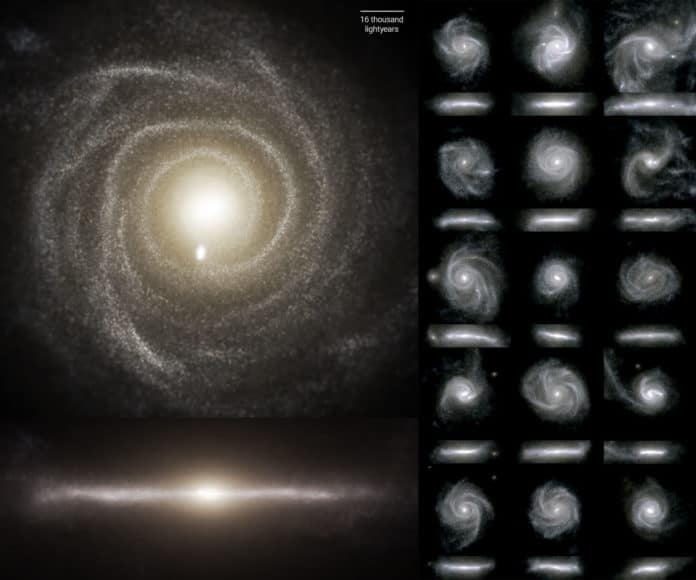Galaxies are thought to begin as small clouds of stars and dust swirling through space. Given the current knowledge, it seems fairly reasonable that there may have been a Big Bang, the primeval explosion that brought all space and time, all matter and energy, into being. The galaxy-formation process has not stopped. Our universe continues to evolve.
To better understand the evolution of galaxies, a team of international scientists has created a newly-completed, state-of-the-art simulation called TNG50. The simulation model enables scientists to examine in detail how galaxies form and how they have evolved since shortly after the Big Bang.
What’s more, this is for the first time, scientists were able to understand better the geometry of the cosmic gas flows around galaxies determines galaxies’ structures, and vice versa.
The model combines the idea of a large-scale cosmological simulation—a Universe in a box—with the computational resolution of “zoom” simulations at a level of detail that had previously only been possible for studies of individual galaxies.
TNG50 is the simulation made by the IllustrisTNG Project, which aims to construct a complete picture of how our universe evolved since the Big Bang by creating an enormous-scale universe without giving up the fine details of individual galaxies.
It does so with over 20 billion particles representing dark (invisible) matter, stars, cosmic gas, magnetic fields, and supermassive black holes. The calculation itself required 16,000 cores on the Hazel Hen supercomputer in Stuttgart, working together, 24/7, for more than a year—the equivalent of fifteen thousand years on a single processor, making it one of the most demanding astrophysical computations to date.
Dr. Dylan Nelson (Max Planck Institute for Astrophysics, Garching) said, “Numerical experiments of this kind are particularly successful when you get out more than you put in. In our simulation, we see phenomena that had not been programmed explicitly into the simulation code. These phenomena emerge naturally, from the complex interplay of the basic physical ingredients of our model universe.”
Dr. Annalisa Pillepich (Max Planck Institute for Astronomy, Heidelberg) said, “In practice, TNG50 shows that our own Milky Way galaxy with its thin disc is at the height of galaxy fashion: over the past 10 billion years, at least those galaxies that are still forming new stars have become more and more disc-like, and their chaotic internal motions have decreased considerably. The Universe was much messier when it was just a few billion years old!”
TNG50 enabled specialists to see firsthand how cosmic systems may have risen out of the turbulent clouds of gas present shortly after the universe was born. They discovered that the disk-shaped galaxies common to our cosmic neighborhood naturally emerged inside their simulation. They delivered inward structures, including spiral arms, bulges, and bars stretching out from their central supermassive black holes. At the point when they contrasted their simulations with real-life observations, they found their populace of galaxies was qualitatively consistent with reality.
Despite these initial findings, the team is far from finished dissecting their model. They also plan to release all of the simulation’s data publicly for astronomers across the world to study their virtual cosmos.
Journal References
- Nelson, D., Pillepich, A., Springel, V., Pakmor, R., Weinberger, R., Genel, S., Torrey, P., Vogelsberger, M., Marinacci, F., & Hernquist, L. (2019). First results from the TNG50 simulation: Galactic outflows driven by supernovae and black hole feedback. Monthly Notices of the Royal Astronomical Society, 490(3), 3234-3261. DOI: 10.1093/mnras/stz2306
- Pillepich, A., Nelson, D., Springel, V., Pakmor, R., Torrey, P., Weinberger, R., Vogelsberger, M., Marinacci, F., Genel, S., & Hernquist, L. (2019). First results from the TNG50 simulation: The evolution of stellar and gaseous discs across cosmic time. Monthly Notices of the Royal Astronomical Society, 490(3), 3196-3233. DOI: 10.1093/mnras/stz2338
